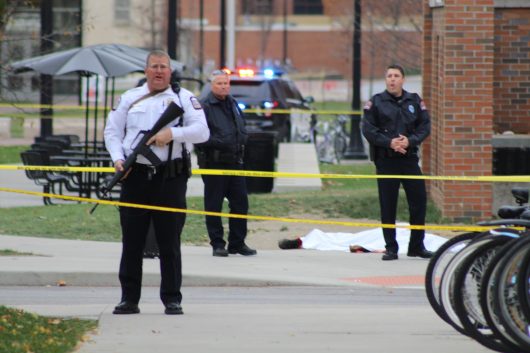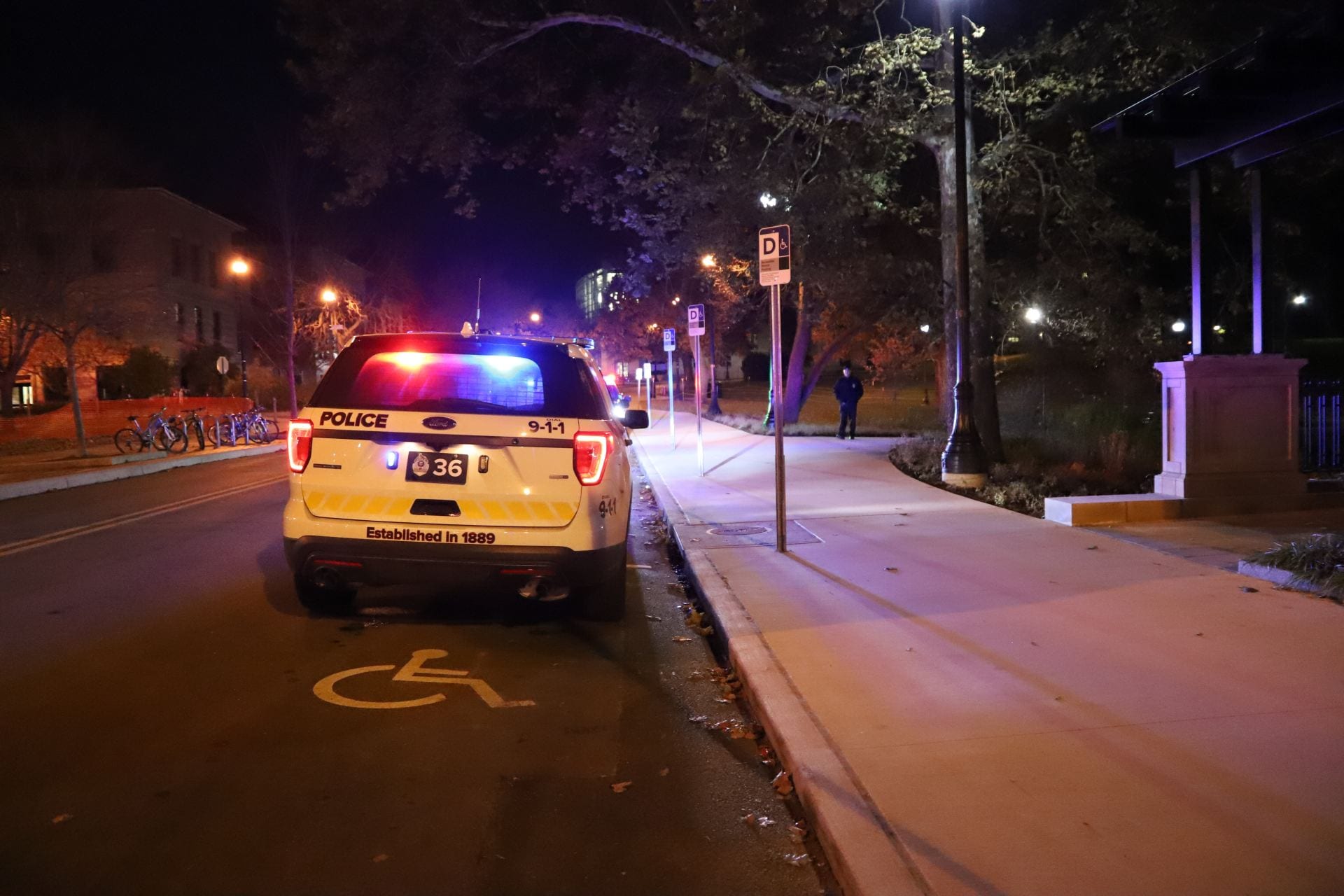
A police officer and two other emergency personnel stand near a body lying near the Chemical and Biomolecular Engineering Chemistry building on North Campus. Credit: Mason Swires | Assistant Photo Editor
Eleven people were injured Monday morning following an attack outside of Watts Hall on the Ohio State campus.
At 9:52 a.m., Abdul Razak Ali Artan, a third-year in logistics management, drove a gray Honda Civic sedan into a crowd of people gathered outside for a fire drill. Artan then leaped out of the vehicle and reportedly began to attack the crowd with a butcher knife. Artan was the only one killed, with others being sent to various hospitals with non-life-threatening injuries, although one was in critical condition. All classes were canceled Monday.
The attack resulted in a Buckeye Alert text message sent to students, and the university declaring a shelter-in-place command across campus. The shelter-in-place order was lifted just after 11:30 a.m., although police officers were still conducting searches in and around the Lane Avenue Garage, where officers looked for other suspects. OSU initially reported there was an active shooter, but police later said that there was neither evidence of a firearm nor other suspects.
Artan was shot and killed by University Police officer Alan Horujko within about a minute of the attack, University Police Chief Craig Stone said during a news conference held Monday. Those injured suffered knife wounds, as well as injuries associated with the motor-vehicle attack, and were transported to three area hospitals.
“Police responded very quickly. Immediately. Twenty seconds. Maybe less. Really quick,” said Michael Cloonan, second-year in welding engineering who was outside of Smith Laboratory at the time of the attack.

A timeline of the series of events during the violent attack that took place on-campus on Nov. 28. Photo illustration by J.L. Lacar | Design Editor
As the story made the rounds across news media on Monday, many were quick to bring up suspicions of terrorism, although no evidence linking Artan to terrorism have been made available.
“I think people should exercise enormous caution based on only a few data points. People need to exercise caution,” said Dakota Rudesill, a professor at the Moritz College of Law. “Even if we were to determine in some way (this attack was an act of terror), people need to be extremely cautious in linking this individual with larger groups.”
Rudesill, a counter-terrorism expert, said there are a number of factors law enforcement consider before ruling something as an act of terror. Circumstantial factors, such as race, religion and country of origin, and direct factors, such as a statement of intent posted on social media or a written letter, play a role in determining an event as terrorism. Though they are important, Rudesill said circumstantial factors alone are not enough to rule something like Monday’s attack as terrorism.
“It’s awfully important for people to differentiate between circumstantial, which could be religious affiliation or ethnicity, and direct factors, like a statement of intent or communication with an individual involved with a terrorism group,” Rudesill said.
At a second news conference, it was said that those injured included four graduate students, three undergraduate students, one faculty member, and one staff member from the traffic and parking department, which is separate from the University Police department. Whether the other victims are associated with the university was unknown as of Monday night.
University President Michael Drake was joined by Ohio Gov. John Kasich and other local elected officials at the 4 p.m. press briefing at the Ross Heart Hospital, who all lauded the efforts of all law enforcement involved in ongoing investigation. Kasich shared a personal anecdote at the news conference about his emotional connection to the university and the students.
“This is where I started … This is just an incredible and magnificent place,” Kasich said. “We are a strong, tough, resilient community and … it’s just not the students who go to school here that count, it’s anybody that has ever touched this place who will think and be affected by what happened today.”
Artan was featured in an August edition of The Lantern, in the print-only feature “Humans of Ohio State.” He expressed anxiety about being new on campus, having just transferred from Columbus State Community College.
Drake sent out an email to students Monday night in response to the incident.
“Days such as these test our spirit as Buckeyes — but together we remain unified in the face of adversity,” Drake said in the email. “I encourage anyone in our community in need of assistance to utilize the university’s resources.”
Multiple vigils were held as a show of support for the victims, starting at 4 p.m. and continuing throughout the evening.

